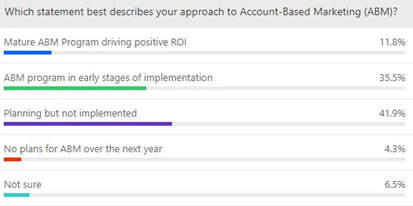[Part 1 of 2 - read Part 2 here]
Millions of words have been written and spoken about account-based marketing (ABM), most of them in the past couple of years. It lacks a common definition, but most commentary agrees that it is characterised by personalisation and a focus on key accounts. If inbound marketing is chumming the water and chucking in a big net, ABM is using a speargun on a fish you’ve been sonar tracking.
It’s understandable that the use of ABM is growing, particularly among enterprise-level B2B marketers. For high-value B2B purchasing decisions, with long sales cycles that are dependent on an intimate understanding of a client’s needs and processes, it makes sense to spend the most time and resources on only the accounts that are likeliest to pay off. The implications of the 80/20 Pareto principle apply to marketing budgets as much as to any part of the business.
Nonetheless, many marketers are at an early stage in their ABM journeys. A poll taken at a recent ABM virtual conference found that just 12% of attendees had a mature ABM programme in place. Around one-third were at the early stages of implementation, and 42% were planning.

Source: ABM Leaders Virtual Forum APAC, October 2020
It’s perhaps a surprise that it’s taken this long for the concept of personalisation to really hit home in broader B2B circles. As consumers, we’ve become inured to it in most of the digital advertising that’s thrown our way for even the most quotidian purchases. I’m old enough to remember the shock I felt on first seeing an ad for something I’d just been googling, or when a bot addressed me by my first name (I’m English, so maybe I’m more liable to take offence at this kind of effrontery.)
First, prepare your furoshiki…
Maybe it’s because this kind of personalisation is, at its core, pretty superficial, that it’s taken longer for many B2B marketers to feel comfortable at devising bespoke strategies for individual accounts. This kind of thing is certainly time-consuming and difficult to get right. For starters, the understanding you must cultivate of each target – and, perhaps, each decision-maker within each target – is somewhat intimidating.
To give an example, a consultant we worked with was focused on reaching senior IT purchasing managers at major banks in Japan. Across the whole of Tokyo, this meant talking to perhaps ten people. After a lot of research into each bank, the issues troubling each one were reasonably well known – they faced common problems in updating legacy technology. In terms of content, then, it wasn’t necessary to start from scratch in each case.
In terms of channel, though, things got complicated. The likelihood of any one of these people reading an email, let alone downloading, printing and reading a PDF attachment, were practically nil. Reaching out on LinkedIn (which has a suite of ABM solutions) wasn’t going to work, either – seeing as its use in Japan is still low.
The solution this consultant employed was to print the new research paper they’d prepared and bind it between leather covers. Then courier it, wrapped in a furoshiki, directly to the people concerned.
This might be an extreme example, but it’s illustrative of the care needed in strategic ABM. In this case, the engagement channel mattered as much as the content. In fact, hyper-personalised content may have been liable to discomfit the target as much as the over-familiar sales bot I encountered, or a straight sales appeal. In this case, it was better to anonymise and disguise key conclusions to avoid that risk, even if the underlying problems that were discussed, and the solutions presented to them, were designed to hit home.
This is why blithe assertions that “buyers prefer personalised interactions, and ABM delivers just that,” aren’t necessarily true. Or at least, they need qualifying: the trick is knowing the appropriate level of personalisation for a given audience.
As to what else is needed for successful ABM, that’s the subject of Part 2.
World-class communications strategy and execution
Contact us to get started